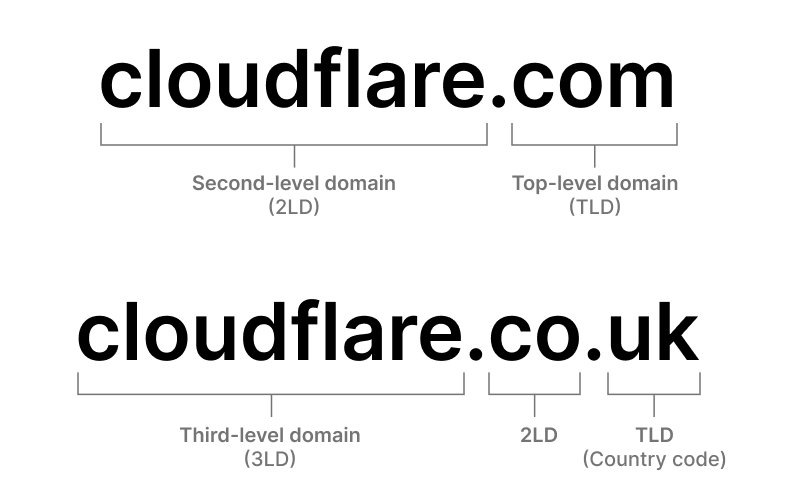如何购买域名
要购买域名,请从声誉良好的域名注册商处购买一个可用的域名。选择正确的注册商可以节省成本。
学习目标
阅读本文后,您将能够:
- 快速查找并购买域名
- 确定需要注意的注册商做法
- 区分域名的各部分
复制文章链接
如何购买域名
购买域名是指从域名注册商处查找并购买一个可用的域名。对于创立新企业、构建 Web 应用程序或启动网站的人来说,学习如何购买域名是重要的第一步。
如要购买域,请执行以下步骤:
- 查找信誉良好的域名注册商
- 确定可用的域名选项
- 选择域名
- 比较不同注册商的价格
- 购买域名
一些网站构建平台也内置了注册商服务,这可能会很方便。Cloudflare 按成本价出售域名,不加价,也不收取费用,并提供一个易于使用的页面来查找域名。
什么是域名?
域名是网站的名称,有时称为“URL”,比如“cloudflare.com”就是一个域名。
使用域名而不是 IP 地址来查找和加载网站。就像每栋房屋和建筑物都有自己的街道地址一样,互联网上的网站和应用程序都有自己的 IP 地址。但 IP 地址是一长串数字(在 IPv6 中为字母数字字符),很难记住和正确输入。因此,为了使 Web 更易于使用,域名系统 (DNS) 将人类可读的域名映射到 IP 地址。用户无需记住大量数字,只需输入“cloudflare.com”或他们喜欢的任何网站即可。
此外,如果网站更换托管服务器,其 IP 地址可能会发生变化。但即使 IP 地址发生变化,DNS 仍允许用户使用他们熟悉的相同域名来访问所需的网站。
域名如何工作
域名有两个或三个主要部分:顶级域名 (TLD)、二级域名 (2LD),以及某些域名还有三级域名 (3LD)。
TLD 位于域名的最末尾,例如“.com”、“.org”或“.gov”,或“.uk”或“.fr”之类的国家/地区代码。网站、企业或服务的名称是 2LD 或 3LD(“cloudflare”是“cloudflare.com”中的 2LD)。

二级或三级域名是域名中最独特的部分。但在购买域名时,考虑顶级域名和国家/地区代码也很重要。顶级域名为“.com”的网站与顶级域名为“.org”的网站给人的感觉是不同的。英国的网站访问者可能更倾向于信任顶级域名为“.uk”的网站,而没那么信任顶级域名不是“.uk”的网站。请注意,域名可能并非在所有 TLD/2LD/3LD 组合中都可用。
如何购买域名:基本步骤
1. 查找值得信赖的域名注册商
域名注册商会列出可供出租的域名,供任何想要建立网站的人使用。一定要找到信誉良好的域名注册商,这些注册商不会收取不必要的费用或进行域名抢注。最好的域名注册商会提供页面,方便您搜索可用的域名。
2. 确定域名选项
列出您找到的可用域名。理想情况下,域名应该简短、直接且容易记住:企业、服务或网站的名称,加上相关的 TLD。域名的价格各不相同,因此请列出可用且在您的预算范围内的选项。请记住,域名的价格是年费,而不是一次性费用。
3. 选择域名
选择最适合您的预算和用例的名称。
4. 比较不同注册商的价格
一些域名注册商对域名加价或收取续订费。(Cloudflare 不会。)因此,在不同的地方购买域名,价格可能会不同。
5. 购买域名
按照注册商的说明完成购买域名的流程。互联网名称与数字地址分配机构 (ICANN) 会跟踪域名的运营者,因此需要提供一些联系信息。
请注意,虽然人们说他们“购买”域名,但事实上域名是租用的。域名注册机构发布和管理域名,并对此收取费用。注册商充当注册机构和网站运营商之间的中间人,他们允许网站运营商以一年、两年或最多五年为期限租用域名。初始租约结束时需要续订域名。
6. 续订域名
大多数注册商会自动续订域名(使用存储的付款方式)。他们会提前 30 天通知,以允许注册人选择不续订。
掠夺性注册商可能不会这样做,而是让域名租约到期,然后以高价将域名卖回给原始注册人。这也是使用信誉良好的注册商很重要的另一个原因。
如果域名的租约到期而没有续约,通常有一个宽限期,在此期间注册人仍然可以买回域名。在最后,域名注册人的记录将被删除,域名将再次向公众开放。详细了解过期域名的处理方式。
一个域名的价格是多少?
域名根据需求和可用性定价。如果一个域名需求量很大,其价格可能会更高。域名注册机构会设定大多数域名的价格。一些注册商会在此基础上加价以从中牟利。可以将注册机构视为向零售商(注册商)销售商品的批发商,然后后者将商品销售给消费者。
请注意,TLD 也是影响成本的一个因素。专用 TLD 的成本高于 .com 或 .org 之类的通用 TLD。
注册商也可能在购买的初始域名期限到期时收取续订费。这会增加域名的成本。
尽管存在所有这些潜在的加价和费用,但仍有许多低成本域名可用。一些域名注册商不会加价或收取费用,从而节省大量成本。
Cloudflare 是否销售域名?
Cloudflare 提供一个完整的平台,用于构建和启动网站和应用程序,还提供保护和加速功能。
平台中也包括 Cloudflare Registrar,这是一项用于购买域名的服务。Cloudflare Registrar 不会对域名加价或收取续订费,仅向客户收取注册机构所收的费用。这带来的成本节省可能非常可观——想想在批发商和零售店购物之间的区别。
Cloudflare Registrar 让您可以轻松查找和购买域名并开始设置网站。立即搜索可用域名。